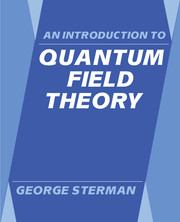Book contents
- Frontmatter
- Contents
- Preface
- PART I SCALAR FIELDS
- PART II FIELDS WITH SPIN
- PART III RENORMALIZATION
- PART IV THE NATURE OF PERTURBATIVE CROSS SECTIONS
- APPENDICES
- A Time evolution and the interaction picture
- B Symmetry factors and generating functionals
- C The standard model
- D T, C and CPT
- E The Goldstone theorem and π0 → 2γ
- F Groups, algebras and Dirac matrices
- G Cross sections and Feynman rules
- References
- Index
E - The Goldstone theorem and π0 → 2γ
Published online by Cambridge University Press: 05 August 2012
- Frontmatter
- Contents
- Preface
- PART I SCALAR FIELDS
- PART II FIELDS WITH SPIN
- PART III RENORMALIZATION
- PART IV THE NATURE OF PERTURBATIVE CROSS SECTIONS
- APPENDICES
- A Time evolution and the interaction picture
- B Symmetry factors and generating functionals
- C The standard model
- D T, C and CPT
- E The Goldstone theorem and π0 → 2γ
- F Groups, algebras and Dirac matrices
- G Cross sections and Feynman rules
- References
- Index
Summary
In this appendix, we discuss three related topics: the Goldstone theorem, chiral symmetry breaking in the strong interactions, and the extraordinary application of the axial anomaly to the decay of the neutral pion. These topics draw heavily on nonperturbative reasoning, and therefore stand somewhat outside our main line of discussion. At the same time, they are so central to our understanding of the standard model as to bear at least brief description.
The Goldstone theorem
As defined in Section 5.4, a symmetry is spontaneously broken when it does not leave the vacuum state invariant. According to the Goldstone theorem, a spontaneously broken symmetry implies the existence of zero-mass scalar particles. The proof of the Goldstone theorem given by Goldstone, Salam & Weinberg (1962) is very accessible, and the reader is referred to their paper for further details. We give a variant of their argument here.
Consider a set of generators Qa, which commute with the Hamiltonian, [Qa, H] = 0, but for which Qa∣0〉 = ∣a〉 ≠ ∣0〉. That is, each Qa acting on the vacuum gives a new, nonzero state. Evidently the vacuum is not unique. We are familiar with this situation from the standard-model Higgs Lagrange density with a wrong-sign mass term, eq. (5.110).
- Type
- Chapter
- Information
- An Introduction to Quantum Field Theory , pp. 532 - 538Publisher: Cambridge University PressPrint publication year: 1993



